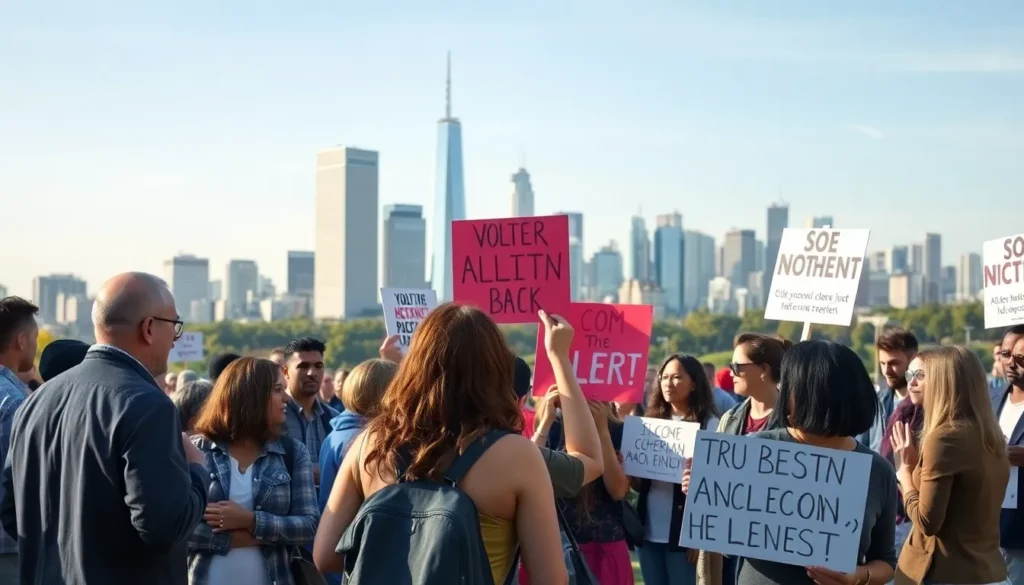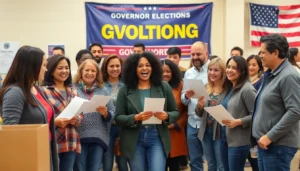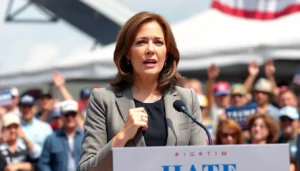Political influence shapes societies in profound ways, affecting everything from policy decisions to social movements. In an age where information spreads rapidly, the power of persuasion has never been more crucial. Individuals, organizations, and governments alike wield their influence to sway public opinion and drive change.
Understanding the mechanisms of political influence is essential for anyone looking to navigate today’s complex political landscape. Whether through traditional media, social networks, or grassroots campaigns, the strategies employed can determine the success of a cause. By examining these dynamics, one can gain insights into the forces that shape our world and the ways individuals can engage in the political process effectively.
Table of Contents
ToggleUnderstanding Political Influence
Political influence significantly shapes societal dynamics, affecting everything from legislation to grassroots initiatives. By grasping its essentials, individuals can better navigate the political landscape.
Definition of Political Influence
Political influence refers to the capacity to affect decisions made by political bodies, public policies, and societal attitudes. This influence manifests through various mechanisms, including lobbying, media portrayal, and social activism. Entities engaged in political influence range from governments and organizations to individuals leveraging platforms for advocacy.
Importance of Political Influence
Political influence plays a vital role in shaping public discourse and policy outcomes. It affects voter behavior, guides legislative agendas, and informs public opinion. Understanding political influence equips individuals to identify the strategies that drive change. Key benefits include:
- Empowerment of Citizens: Citizens engaged in influence efforts can advocate for their interests and affect change in governance.
- Policy Shaping: Political influence impacts crucial legislation, directing resources and establishing priorities within communities.
- Social Movements: Influential campaigns raise awareness around issues, mobilizing support and fostering collective action.
Recognizing the factors behind political influence contributes to informed engagement in civic processes.
Historical Context of Political Influence

Political influence has evolved significantly throughout history, shaping governance, policies, and societal changes. Understanding this evolution provides critical insights into current political dynamics.
Political Influence Throughout History
Political influence has manifested in various forms across different eras. In ancient Rome, public orators swayed opinions through rhetoric, while monarchs leveraged divine rights to justify their rule. The Enlightenment period saw philosophers like John Locke advocate for democracy and individual rights, challenging absolute power. The industrial revolution further transformed political landscapes, with burgeoning social movements driven by labor rights and women’s suffrage. In the 20th century, mass media emerged as a powerful tool for shaping public opinion, influencing elections, and mobilizing social change. Each phase reflects varying degrees of engagement and activism, showcasing how political influence adapts over time.
Key Figures and Their Influence
Prominent figures throughout history played vital roles in shaping political influence.
- Mahatma Gandhi: Advocated nonviolent resistance, significantly impacting India’s independence movement and inspiring global civil rights movements.
- Martin Luther King Jr.: Used powerful oratory and peaceful protests to advance civil rights in the United States, influencing legislation like the Civil Rights Act of 1964.
- Nelson Mandela: His leadership in the anti-apartheid movement highlighted the power of political influence in dismantling oppressive systems and fostering reconciliation.
- Winston Churchill: His speeches during World War II galvanized British resolve against tyranny, exemplifying the impact of communication on public morale and political decision-making.
These figures illustrate how individual actions and strategic communication can profoundly influence political environments and outcomes.
Mechanisms of Political Influence
Political influence operates through various mechanisms that shape public opinion, policy decisions, and societal norms. Understanding these mechanisms is crucial for engaging effectively in the political sphere.
Media and Political Influence
Media serves as a powerful tool for shaping political narratives and public perception. Traditional outlets, such as newspapers and television, alongside digital platforms, reach wide audiences and frame political discourse. Studies indicate that media coverage influences voting behavior and policy priorities (Lippmann, 1922). By using selective reporting, sensationalism, or framing techniques, media entities can amplify certain issues while downplaying others. Social media platforms further enhance this influence by allowing rapid dissemination of information and enabling direct engagement between political figures and citizens. Given that approximately 72% of U.S. adults get news from social media (Pew Research Center, 2021), understanding media dynamics becomes essential for navigating contemporary political landscapes.
Lobbying and Interest Groups
Lobbying involves direct communication between interest groups and policymakers, designed to persuade them to adopt specific positions. Interest groups, including corporations, unions, and advocacy organizations, invest substantial resources to influence legislation and regulation. In the U.S., spending on lobbying reached $3.7 billion in 2022, reflecting its significance in shaping political outcomes (OpenSecrets.org, 2022). Lobbyists present research, policy papers, and expertise to convince legislators of their demands’ merits. Moreover, they cultivate relationships with decision-makers and engage in grassroots campaigns to mobilize public support. The effectiveness of lobbying underscores the need for transparency and regulation, ensuring that the influence of money does not overshadow the public interest.
Case Studies on Political Influence
Case studies illuminate the diverse manifestations of political influence in various contexts. From successful campaigns that transformed public discourse to controversial instances that sparked debate, these examples enhance understanding of how influence operates.
Successful Political Campaigns
Successful political campaigns leverage strategic communication, grassroots mobilization, and digital engagement to shape narratives and voter behavior. Notable examples include:
- Barack Obama’s 2008 Campaign: Utilizing social media for grassroots fundraising and outreach, Obama’s team engaged younger voters effectively. His campaign focused on “Hope” and “Change,” resonating with a diverse electorate.
- Donald Trump’s 2016 Campaign: Trump’s unorthodox approach and direct communication style energized his base. Emphasizing themes of nationalism and economic revival, his campaign harnessed digital platforms to bypass traditional media filters.
- Jacinda Ardern’s Leadership in New Zealand: Ardern’s empathetic communication during crises, including the Christchurch mosque shootings and the COVID-19 pandemic, garnered widespread support. Her compassionate leadership style influenced both national sentiment and international admiration.
Controversial Instances of Influence
Controversial political influence often highlights ethical concerns and challenges democratic norms. Significant cases include:
- Cambridge Analytica Scandal: This incident involved the misuse of data from millions of Facebook users to target political advertisements during the 2016 U.S. election. The resulting outcry raised questions about privacy, data ethics, and the manipulation of public opinion.
- Lobbying by the Tobacco Industry: The tobacco industry’s extensive lobbying efforts aimed to shape smoking policies and public health regulations. Despite substantial evidence linking smoking to health risks, their influence persisted, revealing the complexities of lobbying regulations.
- Foreign Interference in Elections: Reports of foreign entities attempting to sway electoral outcomes, particularly in the U.S. and the U.K., underscore significant threats to democratic processes. These instances provoke ongoing discussions about the integrity of elections and the need for stronger safeguards.
These case studies underscore the multifaceted nature of political influence, illustrating the power dynamics and ethical considerations that shape political landscapes.
The Future of Political Influence
Political influence continues to evolve, shaped by emerging trends and technologies. Understanding these shifts provides insight into the mechanisms that will drive future political landscapes.
Trends in Political Influence
Political influence exhibits several notable trends that will shape future dynamics.
- Increased Polarization: Political discourse is becoming more polarized, with individuals aligning more closely with ideologies that reflect their values. This polarization can amplify conflicts but also motivates activism among more engaged populations.
- Grassroots Movements: The rise of grassroots movements demonstrates a shift towards bottom-up influence. Individuals and local groups mobilize effectively through social media platforms, advocating for policy changes aligned with community values.
- Diverse Coalitions: Political influence now frequently emerges from diverse coalitions. Various groups unite around common causes, enabling broader advocacy for social justice, environmental issues, and economic reforms.
- Focus on Local Issues: Local concerns increasingly capture public attention. Initiatives addressing neighborhood challenges gain traction, attracting local influencers and encouraging community participation in political processes.
The Role of Technology
Technology significantly alters the landscape of political influence.
- Social Media: Platforms like Twitter, Facebook, and Instagram amplify voices, allowing rapid dissemination of information and mobilization of supporters. Political figures and organizations leverage these platforms to engage with constituents directly.
- Data Analytics: Data analytics tools enable campaigns to tailor messages to specific demographics. By analyzing voter preferences and behaviors, political entities can craft strategies that resonate with target audiences.
- Artificial Intelligence: AI-driven tools enhance political campaigns by optimizing messaging and improving voter outreach efforts. AI can analyze trends, predict voter behavior, and identify influential opinion leaders to enhance engagement.
- Blockchain Technology: Blockchain may increase transparency and accountability in the political sphere. It can provide secure voting systems and track lobbying activities, ensuring that public interests are safeguarded.
These trends and technologies collectively redefine how political influence manifests, highlighting the importance of adaptability in navigating future political landscapes.
Political influence remains a powerful force that shapes the fabric of society. Its ability to sway public opinion and drive policy decisions is more crucial than ever in today’s interconnected world. As individuals and organizations harness various strategies—from media engagement to grassroots activism—they contribute to the ongoing dialogue that influences legislative outcomes.
Understanding the mechanisms behind political influence equips citizens to actively participate in shaping their communities. With the rise of technology and social media, the landscape of political engagement continues to evolve, presenting both opportunities and challenges. Recognizing these dynamics can empower individuals to advocate effectively for their interests and engage meaningfully in the political process.





